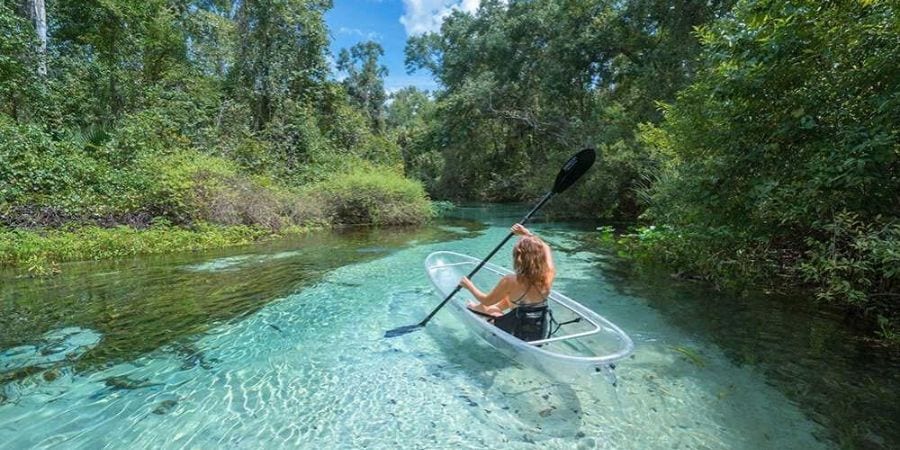
- Alabama
- Alaska
- Arizona
- Arkansas
- California
- Colorado
- Connecticut
- Delaware
- Florida
- Georgia
- Hawaii
- Idaho
- Illinois
- Indiana
- Iowa
- Kansas
- Kentucky
- Louisiana
- Maine
- Maryland
- Massachusetts
- Michigan
- Minnesota
- Mississippi
- Missouri
- Montana
- Nebraska
- Nevada
- New Hampshire
- New Jersey
- New Mexico
- New York
- North Carolina
- North Dakota
- Ohio
- Oklahoma
- Oregon
- Pennsylvania
- Rhode Island
- South Carolina
- South Dakota
- Tennessee
- Texas
- Utah
- Vermont
- Virginia
- Washington
- West Virginia
- Wisconsin
- Wyoming
Surviving Sharks While Kayaking: Essential Safety Tips
kayaking destinations, learn kayaking
- 1 - Is a Kayak at Risk of a Shark Attack in the Water?
- 2 - Do Certain Color Kayaks Attract Sharks?
- 3 - The Great White Shark Threat: Are Kayaks Safe?
- 4 - Shark Attacks in 2020: A Review of the Year's Incidents
- 5 - Can Sharks Knock Over Boats and Kayaks? Understanding the Risks
- 6 - Why Do Great White Sharks Follow Boats and Kayaks?
- 7 - How To Safely Remove A Shark From Your Kayak While Fishing
- 8 - Have Touring Or Sea Kayaks Ever Been The Target Of A Shark Attack?
- 9 - Statistics on Shark Attacks on Kayaks
For those who dream of kayaking, the idea of venturing into the water can be both exciting and intimidating. The prospect of encountering a shark is a real concern for many people, and it's understandable why. However, for those who are determined to kayak, regardless of the risks, it's important to understand the connection between kayaks and sharks and how to stay safe in their presence.
If you're curious about this topic and want to learn more, keep reading this article. We'll cover everything you need to know about kayaking and sharks, including the risks and how to minimize them.
Is a Kayak at Risk of a Shark Attack in the Water?
Will Sharks Attack a Kayak If It's in the Water?
The media often portrays kayaks and sharks as a dangerous combination, but the truth is that shark attacks on kayaks are relatively rare. According to data from the Florida Museum, there were 64 unprovoked shark attacks worldwide in 2019, with 41 of those occurring in the United States. According to Tracking Sharks, there were a total of 101 shark attacks, including both provoked and unprovoked incidents.
It's important to note that in most cases, shark attacks on kayaks are the result of some form of provocation. In 2020, kayaks were involved in only about 9 percent of all shark attacks. So, it's safe to say that sharks are unlikely to attack a kayak without a reason.
If you're a kayaker, it's essential to be aware of the facts and to take necessary precautions to ensure your safety while kayaking in shark-populated waters.
Do Certain Color Kayaks Attract Sharks?
Determining which color kayak is most likely to attract sharks is a complex issue. In the past, yellow was thought to be the most enticing color for sharks, but recent studies have shown that most sharks are colorblind.
Sharks are naturally curious animals and are more likely to be drawn to anything that catches their attention. The bright yellow color of a kayak stands out against the water, making it more noticeable to sharks. However, any light color is likely to have the same impact, as the contrast between the colors will make the kayak more noticeable to the shark.
It's also important to note that sharks are not drawn to color as much as they are to movement. This means that changing the color of your kayak may not make much of a difference in terms of shark attraction.
If you want to minimize the risk, consider purchasing a kayak with a dark-colored hull, such as blue or green, which do not create as striking of a contrast with the water.
The Great White Shark Threat: Are Kayaks Safe?
Kayaks: Are They at Risk from Great White Sharks?
Great White sharks have been known to attack kayaks, but the type of shark you need to be cautious of will depend on the location of your kayaking trip. If you're kayaking in a lake, the likelihood of encountering a shark is very low. However, in the ocean, Hammerhead sharks may pose a greater threat to kayakers in areas where they are hunting for prey.
Great White sharks tend to concentrate in areas with a high density of prey, such as the western and northeastern shores of the United States, southern Australia, northern Japan, South Africa, and New Zealand. These waters are abundant in fish and other marine animals, making them ideal habitats for Great White sharks.
It's essential to be aware of the potential risks and to take necessary precautions when kayaking in shark-populated waters, especially if you are in an area known for Great White shark sightings.
The Size of Great White Sharks: Understanding the Variations
The size of a Great White shark can vary greatly, depending on both the gender of the shark and the specific shark being referred to. On average, female Great White sharks tend to be longer and broader than males, with lengths ranging from 15 to 20 feet. Males, on the other hand, are typically shorter and more compact, with lengths ranging from 11 to 13 feet. Both male and female Great White sharks can weigh anywhere from 1,200 to 2,400 pounds.
There have been rare reports of Great White sharks that reach up to 20 feet in length and weigh 5,000 pounds. These giant specimens have captivated humans for centuries.
The now extinct Megladon shark was once considered the largest shark to have ever lived, but this record has since been surpassed. Despite this, there have been accounts of people seeing a Megladon shark, leading to speculation that one or more of these massive creatures may still be swimming in the ocean today.
However, it's important to note that most reported sightings of Megladons are likely just encounters with exceptionally large sharks, giving the illusion of an unnatural size. In most cases, there is no need to worry about these giant monsters attacking you, as they are not likely to be present.
Shark Attacks in 2020: A Review of the Year's Incidents
According to data from Tracking Sharks, as of December 16, 2020, there have been 78 reported incidents of shark attacks. Despite the ongoing chaos of the year, the number of shark attacks in 2020 is lower compared to the previous year, which had 101 incidents.
However, the number of fatalities has increased, with a total of 12 recorded deaths as of December. This is a significant increase from 2019, which saw six fatalities.
It's important to note that while the number of shark attacks may fluctuate from year to year, it's always important to take necessary precautions and stay informed about the potential risks when participating in water activities.
Sharks in the Water: Understanding the Risks and How to Stay Safe
Encountering a shark is a fear that many people have when participating in water activities. Although it's not a common occurrence, spending time in the water increases the likelihood of eventually encountering a shark.
Sharks are naturally curious animals and may investigate objects in the water from time to time, which can result in an uncomfortable and potentially dangerous situation. It's important to be aware of the risks and to take necessary precautions to ensure your safety while in the water.
If a shark collides with your kayak, it is most likely due to something attached to the kayak. It's important to remain calm and composed in these situations, as panicking can attract the shark and increase the likelihood of an attack.
Sharks are ambush predators, so it's crucial to keep a close watch on them and maintain eye contact if a shark bumps into your kayak. Paddle slowly back to shore while keeping an eye on the shark, and avoid splashing or creating any unnecessary movements.
If a shark becomes aggressive, do not play dead. Instead, use your paddle to defend yourself and try to hit the shark on the nose, which may temporarily stun the animal and force it to stop attacking. However, it's important to be careful when using any object to fight a shark, as hitting the wrong spot could lead to further danger.
Can Sharks Knock Over Boats and Kayaks? Understanding the Risks
It is possible for a shark to knock someone off a boat or a kayak, but such incidents are rare. Sharks often hunt by swimming underneath their prey and launching themselves upwards with great power, which can flip and capsize even large boats and kayaks.
If you are not securely fastened in your watercraft, you run the risk of being thrown into the water if the boat or kayak capsizes. However, even in instances where a shark capsizes a kayak, it is unlikely that the person inside will be bothered by the shark.
It's important to take necessary precautions and be aware of the potential risks when kayaking or boating in shark-populated waters.
Why Do Great White Sharks Follow Boats and Kayaks?
Sharks, including Great White Sharks, are naturally curious animals that rely on their vision to hunt. The presence of a boat or kayak in their territory can pique their interest and lead them to investigate.
Their curiosity and predatory nature often lead sharks to swim alongside boats and kayaks for extended periods, even though they don't always pose a threat. However, it can still be unsettling to see a shark from a distance, regardless of the situation.
Because sharks do not have hands or feet, they use their mouths to investigate objects. Most of the time, they bite to determine the texture of an object, not to kill their prey. Unfortunately, they cannot accurately gauge the lethality of their bites.
It's important to take necessary precautions and be aware of the potential risks when kayaking or boating in shark-populated waters.
How To Safely Remove A Shark From Your Kayak While Fishing
When fishing in the ocean, it's possible to accidentally reel in a shark. If you find yourself in this situation, it's important to remove the shark safely to minimize harm to the animal.
If the shark is small, you can try to use a dehooking tool to remove the hook. If the shark is larger, it's best to cut the line and leave the hook in the shark's mouth. This allows the hook to rust over time and eventually fall out on its own.
It's important to never pull the hook out of a shark's mouth, especially if the shark has already swallowed the hook. This can cause significant damage to the shark's internal organs.
Remember that sharks, for the most part, do not intend to harm people and are usually just exploring the area. It's important to handle them with care and respect to ensure their safety and well-being.
Have Touring Or Sea Kayaks Ever Been The Target Of A Shark Attack?
Regardless, it is important to always take safety precautions when kayaking or participating in water activities, especially in areas where sharks are known to be present. This includes following guidelines and regulations set by local authorities and avoiding engaging in activities that may attract sharks, such as fishing or chumming the water.
It is also advisable to always wear a life jacket, avoid wearing shiny or flashy jewelry, and avoid paddling or swimming near schools of fish, seals, or other prey items that may attract sharks. By following these safety measures, you can reduce the likelihood of a shark encounter and increase your overall safety while kayaking.
Statistics on Shark Attacks on Kayaks
As of 2020, there have been 78 reported shark attacks. Out of the 6,522 recorded shark attacks, only 59 of them involved kayaks, making up 9% of all shark attacks related to kayaking.
The number of shark attacks on individuals is relatively low based on available data. In many cases, the actions of a single person or group can provoke a shark attack. However, if you give sharks and kayaks enough space, they will typically leave you alone.
Frequently Asked Questions
Are sharks attracted to stand-up paddle boards?
Although sharks have indeed attacked paddle boarders, it is essential to note that sharks are not going after humans but may mistake your paddle board or motions for prey.
Is it possible for a shark to attack a kayak?
A shark attack on a kayak is rare but happens occasionally. Twenty-one shark attacks have been recorded since the early 1900s, according to the Global Shark Attack File.
Sharks avoid which colors?
Sharks see contrasting colors, so anything bright against lighter or darker skin can appear as bait fish. Consequently, we suggest swimmers avoid yellow, white, or any bathing suit with contrasting colors, such as black and white.
If you see a shark on a paddleboard, what should you do?
Like surfboards, paddle boards resemble food to sharks. Be aware of your surroundings and paddle away quietly if you see a shark. The vast majority of encounters are nothing more than sightings. Have fun, and stay safe as always.
What kayak`s colors attract sharks?
Although sharks are unlikely to be attracted to any particular kayak color, or kayaks in general, they are attracted to bright colors like fluorescent green or yellow, especially in murky waters.











